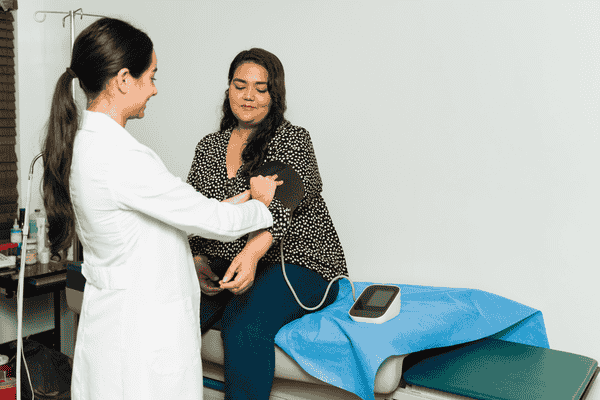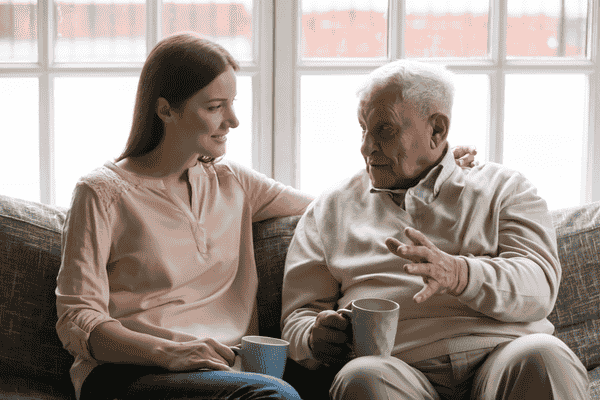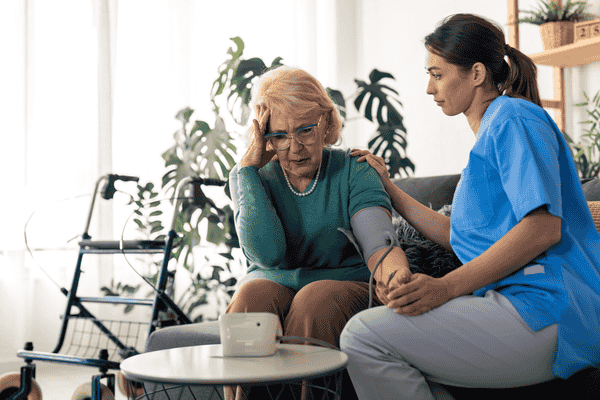Are you struggling to provide compassionate care for an elderly loved one dealing with incontinence? You have an ally. Incontinence can be a significant part of caring for a senior, with ramifications for physical and mental health alike. But there’s hope.
This guide is going to reveal 10 different compassionate ways to handle incontinence in elderly people, which will enable you to rise to the challenge of being a good caregiver. From being informed about different forms of incontinence, to applying some professional management techniques, we assure you that we will be with you all the way.
Learn how to:
• Engage in open communication about this sensitive subject
• Create a supportive environment while keeping dignity
• Select the right incontinence products for comfort and security
• Tackle the psychological ramifications on your loved one
Be you a family caregiver or a professional in this field, these pointers will help you not only give the best care possible, but also enhance your loved one’s existence. Let us be at this journey together and transform the way we see elderly incontinence care.
Understanding Urinary Incontinence in the Elderly
Urinary incontinence is a frequent problem among numerous older adults, influencing their life as daily activities and well-being issues. So what is it specifically, and what is its cause?
Visualize that on a very specific day, you have lost control of the need for using the toilet. Such is the sad truth of many old persons who are confronted with urinary incontinence, and it really can be a problem.
Incontinence can be of many kinds, hence every kind has varied impacts:
Stress Incontinence
This occurs when the bladder sends out the leakage message due to physical stress or pressure. Think of it like sneezing or laughing and all of a sudden, you feel a little pee is going.
Urge Incontinence
This type, called overactive bladder, is a rare, intense urge to pee. It is like you are aware of the need to run to the washroom instantly.
Functional Incontinence
During this time, a person is aware of bladder control, but has difficulty getting to the toilet via physical or mental restrictions. Imagine being ready to go, yet struggling with hopping off a chair quickly.
Mixed Incontinence
A few older adults interchange these types, thus leading to their rough management.
Grasping these classifications is very vital for proper healthcare and its remedies. It is not just about wet clothing or recounting embarrassing moments; it is about dignity, comfort, and the quality of life.
💡 Key Takeaways: The multitude of forms of urinary incontinence in older adults can be managed and knowledge of the same is necessary to improve their quality of life.
Common Causes of Elderly Incontinence
A specific group of older people is unable to go for long without the toilet because of the following reasons:
1. Weak pelvic floor muscles
2. Urinary tract infections
3. Certain medications
4. Neurological conditions like Parkinson’s or stroke
5. Prostate issues in men
In some instances, temporary issues may be caused by a urinary tract infection. In other cases, this may indicate a serious health condition.
It is important to remember that incontinence is not an unavoidable result of aging. In many cases, this problem can be treated effectively or be managed by the right approach at a particular age.
The Importance of Open Communication
Though it may be uncomfortable, having conversations regarding incontinence is key for emotional support and effective management.
Consider being the person who is experiencing the incontinence and feels ashamed to talk about it. The loneliness and stress of doing so can be pretty much unbearable.
When you are the one who is in such a situation, it is of utmost importance to create a space where talking about it is okay. If you are the one who is experiencing incontinence or a caregiver, opening the floor for discussion can be a means for better understanding and care.
To facilitate a higher level of open communication, the following tips will be helpful:
1. Choose a private, comfortable setting
2. Use language that reflects empathy
3. Listen without judgment
4. Share personal experiences where appropriate
Remember, you are not the only one going through it. So many other people have been through similar situations, and if they can be discussed it can make them seem more normal and less embarrassing.
💡 Key Takeaways: Clear, empathetic communication about incontinence is the first step in ensuring effective care, emotional support, decreasing stigma, and increasing contact with the community.
Seeking Professional Help and Diagnosis
The need to see a medical professional regarding the case of urinary incontinence is a necessary and sufficient condition for proper treatment and engineering of its effective management.
Imagine trying to fix a complex machine without any technical knowledge. That’s what it’s like to attempt managing incontinence without expert guidance.
A healthcare provider can offer a comprehensive assessment, considering the following
1. Medical history
2. A physical examination
3. Urinalysis
4. Bladder diary analysis
They may also recommend additional tests to establish the precise cause and type of incontinence.
What to Expect During a Medical Consultation
1. Thorough query concerning symptoms and lifestyle
2. Consideration of treatment options
3. Possible referral to a specialist if necessary
From this perspective, it can be said that asking the doctor for help is not a sign of weakness, it is a positive step to improving your health and quality of life.
Feel free to raise queries or bring up issues with your healthcare provider. Your health practitioner is available to instruct, direct, and assist you in this process.
💡 Key Takeaways: Getting medical expertise is vital for the correct diagnosis and treatment of urinary incontinence, its treatment will improve the quality of life and might successfully manage the symptoms.
Implementing Effective Incontinence Management Strategies
Effective incontinence management necessitates a multipronged approach. Let’s go through it together as it can be a game-changer in everyday life.
Bladder Training
Think of it like educating your bladder into a well-mannered canine. In fact, this is the main purpose of bladder training.
Here’s how it works:
1. Start by keeping a bladder diary to understand your patterns
2. Gradually increase the time between bathroom visits
3. Use relaxation techniques to control urges
For example, if you usually go every hour, try extending it to 75 minutes, then 90, and so on.
Pelvic Floor Exercises
Also known as Kegel exercises, these can strengthen the muscles that control urination.
Here’s a simple way to do them:
1. Identify the right muscles (the ones you use to stop urine mid-stream)
2. Tighten these muscles for 5 seconds, then relax for 5 seconds
3. Repeat 10 times, 3 times a day
Think of it like giving your pelvic floor a mini-workout session.
Lifestyle Modifications
Small changes can have a big impact:
1. Limit caffeine and alcohol intake
2. Maintain a healthy weight
3. Quit smoking
4. Stay hydrated, but avoid excessive fluid intake before bedtime
Remember, consistency is key. These strategies work best when incorporated into your daily routine.
💡 Key Takeaways: Effective incontinence management involves a combination of bladder training, pelvic floor exercises, and lifestyle modifications, all working together to improve bladder control and quality of life.
Creating a Supportive and Safe Environment
A supportive environment can make a world of difference in managing incontinence.
Think about your home. Are there obstacles that make it hard to reach the bathroom quickly? Consider these modifications:
1. Install grab bars in the bathroom
2. Use nightlights to illuminate the path to the toilet
3. Keep a bedside commode for nighttime use
4. Remove tripping hazards like loose rugs
Remember that an accident-free environment care for people and a good place that is safe will also have a positive impact on their independence.
Establishing Regular Toileting Schedule
Routines are easy to be established those way, part of You can regain control through bladder recognition, utilizing the regular toilet schedule. a
It may help you think of your bladder in this way Both “clock” should reset at regular intervals.
Consider the following:
1. Every 2 hours, even if you feel the urge or not, kindly go to the bathroom.
2. With the increase of time, the supply would be improved enhance.
3. No matter if the toilets are demanding or not you must stick to the timetable.
So, in such an approach, it will be possible to train the bladder to hold urine longer, reduce the accidents and be responsible for the bladder function.
Dietary Treatments for Incontinence
Do you know what you eat and drink can determine the degree of incontinence you will face? Below are several food items that can help in controlling this common issue.
The bladder, like a sensitive instrument, could be set off by certain foods and drinks, making it highly reactive, which results in more frequent urges or accidents.
To be successful in your diet, here are some things to keep in mind:
1. Do not have caffeine (coffee, tea, chocolate)
2. Have no more than light drinks.
3. Try to stay away from the very spicy and hot foods
4. Drink plenty of water, but not too much
Changing an example, you can have your very spicy food and the rest of the day you can use the herbal tea instead of your 3 cups of coffee.
It is important to bear in mind that each individual reacts to various stimuli differently. Document your eating habits over a certain period of time to determine the specific triggers in your body.
Additionally, an interesting fact: Cranberry juice is effective not just for urinary tract infections but also for deodorizing urine, a common problem associated with incontinence.
💡 Key Takeaways: Choosing the right diet can certainly manage the incontinence, some foods, and beverages unfortunately can make the situation worse, while others can be of assistance.
Choosing and Using Appropriate Incontinence Products
Choosing the right incontinence products will have a positive effect on comfort and you will feel much more confident. Let’s see how to choose and use them properly.
You can think of a set of devices specifically created for the management of incontinence just like the right products would be for you or your loved one.
Types of Incontinence Products
1. Pads and absorbent liners
2. Protective underwear
3. Adult diapers
4. Bed pads
5. Skin care articles
How to Choose
Some of the things to consider include:
1. Degree of incontinence (light, moderate, heavy)
2. Body size and shape
3. Mobility level
4. Your options
It means for example, a person with a small amount of incontinence can opt for the discreet pads, while for those with heavier incontinence there are more thirsty options available.
Using Products Effectively
1. Change products regularly to maintain hygiene
2. Use barrier creams to protect skin
3. Ensure a snug fit to prevent leaks
It might take more than one attempt to identify the product that works best for you. So don’t feel discouraged if the first option isn’t the right fit.
💡 Key Takeaways: The correct choice of urinary incontinence products and their proper usage is critical in ensuring comfort, dignity, and hygiene. This includes numerous solutions for different needs and preferences available such as:
Taking Care of Personal Hygiene and Skin
Taking care of hygiene greatly aids in keeping the skin sacrosanct while dealing with incontinence. Thus, it is essential to know some tips on how to keep my skin healthy and avoid complications that may occur when there is incontinence.
Your skin is like a fence against anything harmful. If you keep it wet perpetually, this could cause an infection, irritation, or rashes.
Essential hygiene practices include:
1. Cleansing the genital area and/or other affected areas gently after every episode
2. Using mild and water-soluble pH-neutral soaps
3. Patting dry the affected area instead of rubbing it vigorously
4. Applying a barrier cream for protecting the skin
For example, consider a no-rinse cleanser for incontinence care instead of regular soap. It is specifically designed for this purpose.
Moreover, early detecting skin problems can only be achieved through regular monitoring. So prevention must be the top priority.
Another tip is that disposable wipes can be a convenient and hygienic way to clean yourself as well.
💡 Key Takeaways: Maintaining adequate personal hygiene and skin care is key when controlling incontinence, it can also save your skin from breakdown and it translates to achieving better physical comfort as well as overall health.
Handling the Mental Effects of Incontinence
Be aware that incontinence is not just a physiological problem; it carries with it a serious psychological burden. Hence, let’s delve into ways of handling the emotional burdens of incontinence.
Imagine feeling anxious every time you leave the house, worried about possible accidents. This is a part of life for lots of individuals who undergo incontinence.
Common emotional responses include:
1. Embarrassment
2. Anxiety
3. Depression
4. Social isolation
The following are some strategies to help cope:
1. Come together in a support group that can help you connect with those in similar situations.
2. Adopt stress-reduction practices such as meditation or controlled breathing.
3. Do not hesitate to contribute your mental health by going for counseling.
4. Help the family understand the medical condition by educating them about it.
It is natural to feel some amount of frustration or sorrow. The first step in solving these matters is to recognize these feelings.
Bonus tip: You may want to maintain an emotion diary regarding your emotions and to find out what has caused them.
💡 Key Takeaways: The psychological side of incontinence should not be neglected since it is critical for overall health. Such strategies must be considered: learn to find help, control the development of stress, and keep your beloved ones well informed.
Balancing Independence and Assistance
Finding the balance between being self-sufficient and accepting help is as important as ever when it comes to bettering the lives of the elderly with incontinence problems.
Visualize a tightrope walker perplexed as he tries to pluck two points for his fancies. The state of affairs with independence and care, especially dressing, is no different than trying to maintain a balance where both help and independence are involved.
Some suggestions worth noting in order to achieve the equilibrium are:
1. Whenever it is appropriate, promote self-care whenever possible.
2. Offer unobtrusive help when necessary.
3. Noteworthy objects whose use can quench the thirst for independence.
4. Privacy and dignity should always be respected.
For instance, an older parent who can handle daily incontinence alone may need assistance at night.
It is important to remember that the basic goal is to achieve independence while ensuring the safety and proper care of the clients.
💡 Key Takeaways: It is essential to strike a balance between independence and assistance requirements in managing incontinence, fostering dignity, and self-esteem, and managing the condition properly.
Some special considerations for dementia patients
Management of incontinence in individuals suffering from dementia is an area that has its own unique difficulties. We shall look at some methods for rendering medical assistance while maintaining dignity.
Think of putting together a puzzle where the pieces transform in front of your eyes. Caring for a person with dementia and incontinence can feel like that.
Here are some unique considerations:
1. Set up a constant schedule.
2. Help them to use visual elements to go to the washroom.
3. A wise choice is to use clothing that is easy to take off.
4. Be patient and show understanding in the event of accidents.
For example, putting a picture of the toilet on the bathroom door can be a way to guide a person with dementia.
Always keep in mind that the patient may not fully comprehend or remember the incontinence control tactics. The key is to repeat and provide gentle reminders.
💡 Key Takeaways: Management of incontinence in dementia patients requires compassion and inventiveness, while strategies should also consider the dementia-related cognitive challenges.
The Role of Caregivers in Managing Incontinence
It is important to understand that caregivers are an integral part of any incontinence management program and they not only give practical help but also emotional comfort.
Being a safety net is part of the job of caregivers of those suffering from incontinence. A caregiver is always there to catch and support somebody who needs it.
Important roles for caregivers include:
1. Helping with personal hygiene
2. Controlling incontinence items
3. Identifying skin problems
4. Acting as emotional support.
5. Giving health care provider details and timing.
For instance, by way of illustration, a caregiver could create a toileting schedule together with their loved one and gently direct them when it is “Time to go” by using a reminder system built into the device.
The caregiver’s task can indeed be hard and tiresome. It is absolutely necessary for caregivers to “recharge their batteries” so they can heal their own physical as well as emotional wounds.
💡 Key Takeaways: Caregivers are a pivotal force in incontinence care, providing hands-on help and solace, and yet they need to take care of themselves as a priority.
Exploring Treatment Options and Exercises
These options are helpful for recovering from incontinence. Some of the different therapies are worth the attention of patients with bladder dysfunction, as mentioned in this article.
Think of a bag full of different tools. These tools are all the different ways you can choose from to manage your incontinence.
Medical Treatments
1. The medication should reduce excessive contraction of the bladder.
2. Botox therapy relaxes dysfunctional muscles.
3. Nerve stimulation therapies
Exercises and Therapies
1. Pelvic floor exercises (Kegels)
2. Biofeedback therapy
3. Bladder training
Through these, for instance, biofeedback therapy is one such therapy that utilizes sensors to allow the visualization of one’s pelvic floor muscle contractions thereby reinforcing the efficacy of the exercises.
There is evidence to suggest that different treatments may work for different people. Therefore it is best to consult a qualified healthcare professional who can formulate an individualized therapy plan which can be followed more easily.
💡 Key Takeaways: For the management of the incontinence problem, a variety of therapy options and exercises are available from the use of medications to physical modes of therapy, the best at hand depends on the individual circumstance.
When to Seek Additional Professional Help
Many issues with incontinence can be handled adequately while being at home, however, there are those times when one needs professional assistance. In the following, we will look into when one should contact their healthcare provider.
Visualize your incontinence management as a car. Sometimes, you have to depend on a professional mechanic to look into the engine.
Seek additional help if:
1. Incontinence suddenly worsens
2. You experience pain or burning during urination
3. There’s blood in your urine
4. Incontinence is affecting your quality of life significantly
For example, if you’ve been managing okay but begin to have accidents often, then it is probably time for you to see a doctor.
It’s always good to know that you can ask for support. It is often the case that prompt treatment will lead to improved results.
💡 Key Takeaways: Recognizing when to turn to a professional is a critical part of being in control of incontinence. Getting up and talking to a medical expert is one of the signs that one’s life quality is severely affected by incontinence, and hence it is vital.
Navigating Challenges in Incontinence Care
Caring for someone with incontinence or managing it yourself can be quite hard. Let’s look at some common obstacles and the ways to overcome them.
For a moment, imagine a winding and ever-changing maze. Trying to deal with the irritating side of incontinence can feel just like that.
Some of the most common problems are:
1. Nighttime incontinence
2. Skin irritation
3. Odor control
4. Social limitations
For instance, when dealing with nocturia, you can go for stronger absorbent products as well as limit fluids before sleep.
Every challenge has a corresponding solution, so you should keep in mind. A solution may be discovered through different possibilities. You need to be creative and not fear trial and error in this area
💡 Key Takeaways: Adjusting to incontinence care challenges necessitates inventiveness, being patient, and being open to testing out various remedies, and every obstacle has a possible management plan.
Long-term Management and Quality of Life Considerations
Managing incontinence is not merely a short-term need, i.e., fulfilling calls but also preserving the quality of your life shall be your priority. We are going to discuss some issues you should consider for the long haul.
Like a planning a trip, you must make plans for both the short term and long term. Therein lies managing incontinence for the long haul: overhead and detail focus.
Key considerations include:
1. Regular health check-ups
2. Adapting strategies as needs change
3. Maintaining social connections
4. Focusing on overall well-being, not just incontinence
For example, a wellness center for the aged where they hold aerobics classes would ease the stress caused by isolation, improve muscle strength, and allow them to connect socially with peers. Other health services are also compromised by the physiologically weak, musculoskeletal imbalances elderly the willingness to exercise is progressively deteriorated due to such workouts and increased availability. So, the drawcard for I suppose was the fact that I am a beautiful personable person and so they do not mind if I am a little uncoordinated. Swimming is an activity both a group and a person can do, hence it is an opportunity to meet new friends while keeping physically fit.
Incontinence does not define a person. Individuals can lead full, active lives through proper medical treatment, thus even they become so passive.
💡 Key Takeaways: Long-term management of incontinence focuses on maintaining overall quality of life, balancing physical care with emotional well-being and social engagement.
Conclusion
Managing elderly incontinence with compassion and understanding is key to maintaining dignity and quality of life. By implementing the strategies discussed, from open communication to proper product selection, caregivers can significantly improve the well-being of their loved ones. Remember, every small step towards better management can make a big difference in an older adult’s daily life. Don’t hesitate to seek professional help when needed, as healthcare providers can offer tailored solutions and support.
As you embark on this caregiving journey, stay patient and empathetic. Your efforts in creating a supportive environment and maintaining open dialogue will foster trust and comfort. By addressing both the physical and emotional aspects of incontinence, you’re not just managing a condition – you’re enhancing overall quality of life. With the right approach and resources, you can turn this challenging situation into an opportunity for growth, understanding, and improved care.













